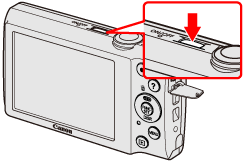Solution
Connecting the Computer and Camera
1. Connect the [DIGITAL Terminal] to the computer's USB terminal by using the [Interface Cable] that came with your camera.

Camera's [DIGITAL Terminal]

[Interface Cable]

PC's USB terminal
CAUTION
A USB cable (camera end: Mini-B) may not be included with some camera models.
If you have more than one Canon camera, please check the items bundled with the additional camera(s) to see whether an USB cable is included. In some cases, USB cables from other Canon camera models can be used to make connections. If you do not have more than one Canon camera, or if a USB cable is not included with any of the Canon cameras you own, please purchase the Interface Cable IFC-400PCU (sold separately).
NOTE
- In this section, Windows 7 is used as an example. The on-screen displays and operations may differ in Windows 8, Windows XP, Windows Vista, or Mac OS X.
- The example below shows the setting procedure for the PowerShot A2300. The position and shape of operational buttons may differ depending on the model you use.
2. Press the <Power> button on the camera.
REFERENCE
When the camera and computer become capable of communicating, CameraWindow will start. Proceed to the "Operate CameraWindow" step below.
- If using Windows Vista or Windows XP
When the [AutoPlay] screen* appears, click [Downloads Images From Canon Camera].
If the screen does not appear, click [Start] (

) > [All Programs] or [Programs] > [Canon Utilities] > [CameraWindow] > [CameraWindow].
* Sometimes this appears even if you are using Windows 7.
After that, proceed to the "Operate CameraWindow" step below.
3. Click the (

) icon displayed in the [taskbar].
4. The following window appears.
Click [Change Program] under [Import pictures and videos] (

).
NOTE
If [Downloads Images From Canon Camera] (

) is already selected, proceed to Step 6.
5. The following window appears.
Select

[Downloads Images From Canon Camera], and click

[OK].
6. Clicking [OK] in the previous step returns you to the screen shown below.
Double-click [Downloads Images From Canon Camera].
1. The following window appears.
2. The [CameraWindow] menu appears. Click

[Import Images from Camera].
REFERENCE
By default, the imported images will be saved separated by each shooting date in the picture folder.
To change the destination folder, click

(

)in the upper-right corner of the window shown in Step 2, and then follow the procedure below.
Click

[Import] >

[Folder Settings] >

[Browse], and specify a folder as the destination folder.
Confirm the destination folder

that you have specified.
Then, click

[OK].
3. A window like the one shown below appears, so click

[Import Untransferred Images] or

[Import All Images].
REFERENCE
3-1. To select and import images, click [Select Images to Import] in Step 3.
3-2. Select

the images you want to import, and then click

[Import] (

).
3-3. The software starts importing images. After this step, please follow the subsequent procedures below.
4. The following window appears, and the computer starts to transfer images from the camera.
6. The following window appears.
Click the (

) button to close this window.
NOTE
A related application ([ImageBrowser EX] by default) will start automatically and the imported images are displayed.

 Camera's [DIGITAL Terminal]
Camera's [DIGITAL Terminal] [Interface Cable]
[Interface Cable] PC's USB terminal
PC's USB terminal
 ) > [All Programs] or [Programs] > [Canon Utilities] > [CameraWindow] > [CameraWindow].
) > [All Programs] or [Programs] > [Canon Utilities] > [CameraWindow] > [CameraWindow]. 
 ) icon displayed in the [taskbar].
) icon displayed in the [taskbar].
 ).
).
 ) is already selected, proceed to Step 6.
) is already selected, proceed to Step 6.

 [Downloads Images From Canon Camera], and click
[Downloads Images From Canon Camera], and click  [OK].
[OK].

 [Import Images from Camera].
[Import Images from Camera].
 (
( )in the upper-right corner of the window shown in Step 2, and then follow the procedure below.
)in the upper-right corner of the window shown in Step 2, and then follow the procedure below.
 [Import] >
[Import] >  [Folder Settings] >
[Folder Settings] >  [Browse], and specify a folder as the destination folder.
[Browse], and specify a folder as the destination folder. that you have specified.
that you have specified. [OK].
[OK]. [Import Untransferred Images] or
[Import Untransferred Images] or  [Import All Images].
[Import All Images].

 the images you want to import, and then click
the images you want to import, and then click  [Import] (
[Import] ( ).
). 



 ) button to close this window.
) button to close this window.